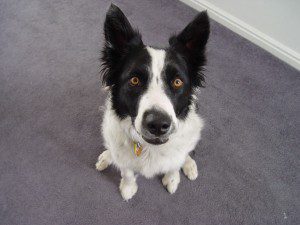Since we have no herding news of our own, after a long lapse in lessons due to non-stop work and family demands, today Champion of of My Heart looks at how someone else uses some clicker training in a herding context.
Herding is often taught using mostly pressure and “corrections.” And, when you ask about how clicker training might fit into the process, you’ll hear some grumbling about things like:
- The livestock are their own “reward.”
- Clickers make dogs focus too much on you and not on the task at hand.
- It’s a natural, much more dynamic process than teaching another kind of trick or easily segmented task.
So, when our pal Anna from Happy Healthy Pup, who recently relocated from Salt Lake City, Utah, to Atlanta, Georgia, suggested I talk to Astrid Smith from A Dog’s Journey … well, I sent and email and got on the phone.
Dog Behavior Problems and Herding

Astrid lives with several herding breed dogs, including both border collies and cattledogs. One of them — Ryddick — has some serious dog-dog issues rooted in all kinds of things that went sideways when he was a puppy.
Astrid used many of the same dog training strategies and methods we have with Lilly, including ideas from Click to Calm and Control Unleashed. For example, you can see Ryddick doing mat work in this video shot at an agility event.
Ryddick comes from working dog lines and should, as the theory goes, be a natural at herding. His generalized snappishness and reactivity, however, made for some interesting herding lessons.
You see, Ryddick … gets aggressive when pressured while working sheep. Most dogs back off from pressure. Ryddick doesn’t.
And, even though Astrid (a dog trainer, herself) told her herding instructor from the get-go that herding should be fun for Ryddick and not to use a heavy hand, he gets over threshhold and has “outbursts” when pressured.
I cannot do justice to their story in a single blog post, but here are the big points:
- Ryddick, like Lilly, tends to follow the livestock too close.
- Ryddick typically works with fewer sheep at once (than we have with goats).
- Ryddick tends to change direction now (rather than get aggressive or shutdown) when pressured.
Dog Training: Clicker Use In Herding —> LIE DOWN
Astrid used the clicker to solidify Ryddick’s DOWN around the livestock. It was a challenge because as the sheep relaxed from the lack of pressure from him, they would move, and he would want to move again to control them. It’s a common issue.
Astrid essentially clicked/treated each stage of the initial approach to ensure Ryddick stayed under threshold at the beginning of each lesson:
- Click for heeling.
- Click for LIE DOWN.
- Click for when the leash comes off.
She also began to click him for LIE DOWN while working sheep. To ensure his related food reward, Astrid:
- Calls for, then clicks for LIE DOWN.
- Releases Ryddick to come get his food reward with the we’re-done-for-now cue THAT’LL DO.
Dog Training: Clicker Use In Herding —> DRIVING, NOT FETCHING
Broadly speaking, border collies have a fetching style of herding … while other herding breeds tend to be more driving in their style. To get Ryddick to DRIVE the sheep better, Astrid and her trainer used another dog to get the sheep against the fence, then clicked/treated Ryddick when he got the sheep to move off the fence.
The fence and placement of dogs meant the sheep could ONLY move one direction, and this essentially set Ryddick up to SUCCEED by moving the livestock in a single direction.
To exercise better distance control between Ryddick and the sheep, Astrid uses a verbal marker “RIGHT THERE” when he is in a good spot.
That means, she ONLY uses the clicker when she wants Ryddick’s attention to be off the sheep … like when she calls for LIE DOWN or THAT’LL DO.
We don’t have the luxury of making a herding video of Ryddick that shows all these exact ideas in practice, but you can check out one of his herding videos, if you’d like to see him working.
Herding Advice for Us
Astrid and I chatted for a long time about our dog’s shared behavior issues and herding lessons. Her best advice for me was to:
- Keep herding FUN for Lilly
- Figure out what her breaking point is and stay below that (so that she doesn’t shutdown)
It’s good, fundamental advice in any dog training scenario. Still, because I find herding SO MUCH harder than the other kind of training we done, I know that Lilly and I have a long way to go.
If you’ve come to our herding stories already in progress, you can catch up via these posts:
Lilly’s Herding Instinct Test, Part 1
Lilly’s Herding Instinct Test, Part 2
Lilly’s Herding Instinct Test, Part 3
Lilly’s Herding Instinct Test, Reflections
Lilly’s Herding Lesson #1, Part 1
Lilly’s Herding Lesson #1, Part 2
Lilly’s Herding Lesson #1, Part 3
Lilly’s Herding Lesson #1, Part 4
Lilly’s Herding Lesson #1, Part 5
Lilly’s Herding Lesson #1, Reflections
Lilly’s Herding Lesson #2, What Went Well
Lilly’s Herding Lesson #2, What Didn’t Go Well
***
We have many more stories and adventures to share. If you’d like to support our efforts, please nominate Champion of My Heart as Best Dog Blog. (Nominations end June 29, and every single nomination matters.) Thanks!



How interesting Roxanne. I was wondering how most people who train or compete with herding dogs felt about the clicker. You provided the answer.
I think for those who are good at sheep herding training, words can work just as well, but for me a clicker would be ideal.
Clearly, I have a lot to learn. In the video, Ryddick seems to keep quite a distance for the most part, so how close is too close to the sheep? And, when he runs off for a perimeter check is that a reaction to the pressure? It seems like he gets too excited and has to do a perimeter check to calm down. Am I misreading his behavior?
I love the clicker, as you know, Mel, but our trainer worries it makes Lilly focus too much on me … and not enough on the goats, so that is one drawback, but I think the idea of teaching some of the fundamental behaviors (like a solid down or being able to call a dog off the livestock) benefit from clicker work.
We’ve never quite gotten the distance thing in our training, but essentially the dogs needs to be far enough away NOT to spook the livestock, but close enough to control them. Learning a particular flock’s “flight zone” is important.
The goats we work are VERY “dog broke,” as they say, so their flight zone is almost ZERO. So, Lilly gets right up on them, which isn’t ideal.
I don’t know enough about Ryddick to say for sure, but yes … usually if a dog disengages from the flock, then that’s a stress thing, like, “If you’re not going to let me do what I want, then I won’t play.” Lilly disengages if there is too much pressure, so we work for like 10 minutes, then take a break, then work again, etc.
Was wondering if you’d had time to revisit herding with Lilly. Reading your description of using the clicker with Ryddick demonstrates just how much work it takes to figure out a method of training something so difficult for a dog.
The more I learn about it, the more I realize that 90% of training is planning with about 10% being the execution.
I really like this one. I’ve always wanted to try out herding with my australian shepherd, but we’d both be terrible at it. And I think she’d have problems similar to these.
Actually…I think she’d just lose it and start running around like a crazy dog and going OMG SHEEEEEEEEP SHEEEEEEEP.
I have to ask, though, because I’ve never really understood the deal with the clicker. Don’t get me wrong – I have a few and I have trained behaviors with them, but I tend to get the same results as using a verbal signal. My timing is good – I’ll boast and say great for this example – and I’ve never found the difference.
Do you train the dogs that the clicker means a better reward? A better job done?
I guess the question is, really, is it necessary for any of the training you’ve described? A tool you choose to use for another reason?
(Can you tell I’m not a clicker trainer? lol. Figured I’d ask to see what you think about it, though.)
Let’s see, JJ, if I can answer your question. Essentially, using a verbal marker (instead of a clicker) comes from the same principle of having a sound come before the reward (usually food). Very basic conditioning that says noise = reward.
The clicker (for most people) is just faster and more precise when you’re trying to capture a behavior.
And, I’d have to dig around for the actual citation, but there was one study that concluded that dogs learned like 1/3 faster via clicker than verbal marker.
So, no … the clicker doesn’t necessarily mean a BIGGER reward or anything like that (unless someone uses a jackpot in certain situation).
Perhaps some of our science-of-learning friends can explain it better … maybe Deborah or Sam?